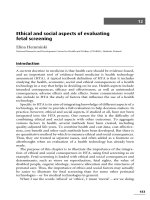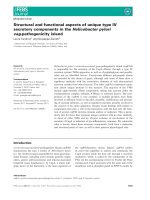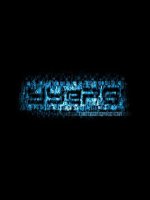Personality classic theories and modern research 6th chapter 4 neo analytic and ego aspects of personality
Bạn đang xem bản rút gọn của tài liệu. Xem và tải ngay bản đầy đủ của tài liệu tại đây (256.69 KB, 32 trang )
Personality
Sixth edition
Chapter 4
Neo-Analytic and Ego
Aspects of Personality
Copyright © 2016, 2012, 2009 Pearson Education, Inc. All Rights Reserved
Modules (1 of 2)
Introduction: Neo-Analytic and Ego Aspects of Personality
4.1: Carl G. Jung and Selfhood
4.2: Alfred Adler
4.3: Karen Horney
4.4: Anna Freud and Heinz Hartmann
4.5: Object Relations Theories
4.6: Erik Erikson
Copyright © 2016, 2012, 2009 Pearson Education, Inc. All Rights Reserved
Modules (2 of 2)
4.7: Modern Approaches to Identity
Conclusion: Neo-Analytic and Ego Aspects of Personality: Identity
Copyright © 2016, 2012, 2009 Pearson Education, Inc. All Rights Reserved
Learning Objectives (1 of 2)
4.1: Probe the development of the Carl Jung school of psychology as distinct from that of
Freud
4.2: Recognize the three fundamental social issues that need to be addressed as
suggested by Alfred Adler
4.3: Describe Karen Horney's theories on culture and feminism
4.4: Report the work done by Anna Freud and Heinz Hartmann on psychoanalysis
Copyright © 2016, 2012, 2009 Pearson Education, Inc. All Rights Reserved
Learning Objectives (2 of 2)
4.5: Analyze the object relations theories as propagated by different theorists
4.6: Examine how identity formation is a lifelong process as propagated by Erik Erikson
4.7: Express the modern approaches to identity
Copyright © 2016, 2012, 2009 Pearson Education, Inc. All Rights Reserved
Introduction: Neo-Analytic and Ego Aspects of Personality
− Cliques and puppy love
− Complexes
− Neo-analytic
Copyright © 2016, 2012, 2009 Pearson Education, Inc. All Rights Reserved
4.1: Carl G. Jung and Selfhood
Objective: Probe the development of the Carl Jung school of psychology as distinct from that of Freud
Examples
Explanation
Copyright © 2016, 2012, 2009 Pearson Education, Inc. All Rights Reserved
4.1.1: Background to Jung’s Approach
− Childhood beliefs
− Beginnings of his theory
Copyright © 2016, 2012, 2009 Pearson Education, Inc. All Rights Reserved
4.1.2: Jung’s Analytic Psychology
− The conscious ego
− The personal unconscious
− The collective unconscious
− Complex
− Functions and attitudes
Copyright © 2016, 2012, 2009 Pearson Education, Inc. All Rights Reserved
Figure 4.1: Fear of Snakes.
Evidence ranging from Eve’s encounter in the Book of Genesis to modern experimental research in primatology and experimental psychology (Shibasaki
& Kawai, 2009) suggests that humans share an evolved fear of snakes. People are quick to notice snakes, very quickly learn to fear snakes, and can react to
snake stimuli outside of conscious awareness (Ohman & Mineka, 2003). Such findings may indicate that the human brain has a form of “collective unconscious.
Copyright © 2016, 2012, 2009 Pearson Education, Inc. All Rights Reserved
4.2: Alfred Adler
Objective: Recognize the three fundamental social issues that need to be addressed as suggested by Alfred Adler
Early life
Theoretical constructs
Copyright © 2016, 2012, 2009 Pearson Education, Inc. All Rights Reserved
4.2.1: Adler’s Differences with Freudian Theory
− Overview
− Point of contention
Copyright © 2016, 2012, 2009 Pearson Education, Inc. All Rights Reserved
4.2.2: Adler’s Individual Psychology
− Striving for superiority
− Concepts
− The role of birth order
− Personality typology
Copyright © 2016, 2012, 2009 Pearson Education, Inc. All Rights Reserved
4.3: Karen Horney
Objective: Describe Karen Horney's theories on culture and feminism
Life history
Similarities with Adler
Copyright © 2016, 2012, 2009 Pearson Education, Inc. All Rights Reserved
4.3.1: Rejection of Penis Envy
− Horney’s reasons
− What women really wanted
Copyright © 2016, 2012, 2009 Pearson Education, Inc. All Rights Reserved
4.3.2: Basic Anxiety
− Reasons
− Different styles
Copyright © 2016, 2012, 2009 Pearson Education, Inc. All Rights Reserved
4.3.3: The Self
− Real self
− Despised self
− Ideal self
Copyright © 2016, 2012, 2009 Pearson Education, Inc. All Rights Reserved
4.3.4: Neurotic Coping Strategies
− Moving toward
− Moving against
− Moving away
Copyright © 2016, 2012, 2009 Pearson Education, Inc. All Rights Reserved
4.3.5: Horney’s Impact on Psychoanalytic Thinking
− Transcending emphases
− Horney’s beliefs
Copyright © 2016, 2012, 2009 Pearson Education, Inc. All Rights Reserved
4.4: Anna Freud and Heinz Hartmann
Objective: Report the work done by Anna Freud and Heinz Hartmann on psychoanalysis
Anna Freud’s works
Heinz Hartmann’s works
Copyright © 2016, 2012, 2009 Pearson Education, Inc. All Rights Reserved
4.5: Object Relations Theories
Objective: Analyze the object relations theories as propagated by different theorists
Overview
Overlap in theories
Copyright © 2016, 2012, 2009 Pearson Education, Inc. All Rights Reserved
4.5.1: Margaret Mahler and Symbiosis
− Symbiotic psychotic children
− Normal symbiotic children
Copyright © 2016, 2012, 2009 Pearson Education, Inc. All Rights Reserved
4.5.2: Melanie Klein, Heinz Kohut, and the Relational Perspective
− Klein’s contributions
− Kohut’s works
− Relational perspective
Copyright © 2016, 2012, 2009 Pearson Education, Inc. All Rights Reserved
4.5.3: The Contributions of Object Relations Approaches
− Overview
− Neo-analytic ideas
Copyright © 2016, 2012, 2009 Pearson Education, Inc. All Rights Reserved
4.6: Erik Erikson
Objective: Examine how identity formation is a lifelong process as propagated by Erik Erikson
People who expanded psychoanalytic theorizing
Erikson’s contributions
Copyright © 2016, 2012, 2009 Pearson Education, Inc. All Rights Reserved









